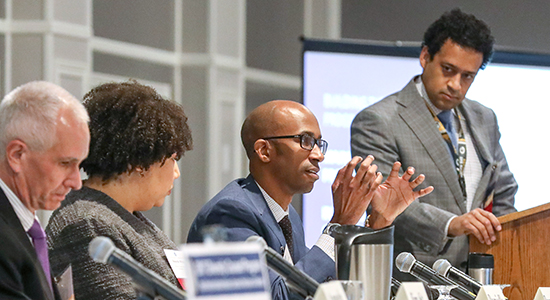
Raymone Jackson, second from right, director of Diversity and Inclusion at Northwestern Mutual in Milwaukee, discusses strategies to implement diversity and inclusion in the workplace at the panel program in December. From right: J. Wesley Warren, Northwestern Mutual Legal Department, Milwaukee; Jackson; Danielle White, legal counsel for Rockwell Automation, Milwaukee; and Jim St. Vincent, chief human resources officer with American Family Insurance Co., Madison.
Feb. 7, 2018 – No matter the size of your office, there’s no question: Having a diverse workforce in your firm is good for business.
“Study after study shows that having a diverse workforce boosts business results,” said Judge Joe Donald of Milwaukee County Circuit Court, speaking as master of ceremonies at the CLE program, “Today’s Diversity and Inclusion Programs: Successes, Ethical Issues, and Challenges” sponsored by the State Bar of Wisconsin Diversity and Inclusion Oversight Committee, held in Milwaukee on Dec. 11, 2017.
“Whether you’re a large company or firm, or a small firm, or even a solo attorney, anything you do to be more diverse makes you a better, stronger firm,” said Danielle White, legal counsel for Rockwell Automation, Milwaukee, and a panelist in the program. “Attorneys can recognize true success when they leverage diversity to add value to their firms and companies.”
Diversity: Not a Program – a Business Imperative
Did You Know?
“At the associate level, women and African-Americans remain less well-represented than they were before the recession (2009), a finding that is both discouraging and significant. … There are many jurisdictions where the disparities in representation are stark.” 2017 Report on Diversity In U.S. Law Firms, National Association for Law Placement, Inc.
With law firms needing to stay competitive in an increasingly complex legal field, exploring and committing to diversity and inclusion has become a business imperative.
“Diversity and inclusion isn’t just so you can ‘feel good,’” said panelist Raymone Jackson, director of Diversity and Inclusion at Northwestern Mutual in Milwaukee. “If executed correctly, it is a game changer that boosts your success.”
It’s about the bottom line: Leadership that includes gender diversity is positively correlated with higher profitability, and companies with the most ethnically diverse executive teams are 33 percent more likely to outperform their peers on profitability, according to a recent study.1
“From a dollars and cents standpoint, it’s there,” Jackson said. “Diversity and inclusion means engagement, which also equals productivity. It makes good business sense.”
The idea is for you and your employees to be comfortable enough to bring your whole self to work – that is very important, especially in a small firm.
Consumers – including potential clients – expect diversity and inclusion as a key component of an organization’s priorities. “For many, they will screen the companies they choose to do business with,” Jackson said. “And they expect companies to put their money where their mouth is.”
Danielle White serves as a board member for the Wisconsin Association of African-American Lawyers (WAAL). WAAL regularly receives emails from potential clients looking for African-American lawyers. “They want the people who represent them to look like them,” White said. “When they are spending their dollars on legal services, they want to go to their comfort zone.”
“It increases the likelihood of your firm being hired when clients can relate to you,” White said.
Cultural competency (an understanding that everyone’s life experiences are different from your own) can improve your conversations with your clients.
Firms should mirror their clients – not just with employees, but in their advertising and their policies, said Jim St. Vincent, chief human resources officer with American Family Insurance Co. and a program panelist. “We’ve got to have the same thought processes as our potential customers have out in the market.”
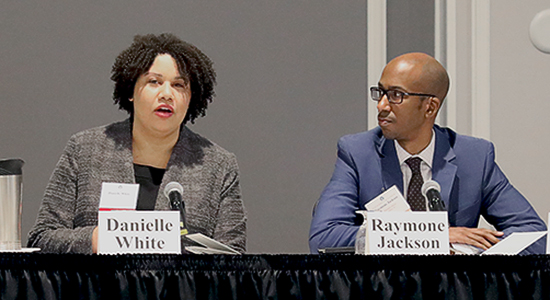
Danielle White, legal counsel for Rockwell Automation, Milwaukee, discusses success strategies for diversity and inclusion.
Diversity Is Intentional
Diversity encompasses many viewpoints: Light or dark skin, old or young, fat or thin, female or male, religious or agnostic, ability or disability, lesbian/gay or straight, right- or left-handedness, and upper Midwesterner or not.
Shannon Green is communications writer for the State Bar of Wisconsin, Madison. She can be reached by email or by phone at (608) 250-6135.
Diversity is reflected not only in employees of a firm, but in its advertising, in the thought processes of its leadership and staff, in its policies and procedures, and more. Ensuring diversity and inclusion in your firm requires intention and planning, says Jackson.
Why now? “It’s to attract the workforce you need in the future,” said St. Vincent. “Look around you. The country’s changing.”
While diversity and inclusion is complicated and nuanced, it is necessary to allow employees to fully contribute to the firm. It is an essential component of maximizing the potential of your employees, Jackson said.
So how do you create your best possible workforce – employees who are free to bring their full selves to work?
Components of an Effective Diversity and Inclusion Program
-
Attitude: Think of it as a business imperative, not a “program” – make the most of those you invest in.
-
Leadership takes ownership, becoming advocates who drive the strategy.
-
Make it fit your firm.
-
Human resources (HR) is a facilitator. Ensure HR policies use inclusive language, such as in health care policies, succession planning for leadership, etc.
-
Diversity and inclusion efforts need ongoing, consistent support. Set benchmark goals, monitor progress, make adjustments as you go along.
-
Create a welcoming culture for all: Foster internal networking and discussion, including having an open door policy for difficult conversations; create support groups.
-
Ongoing education: Use coaching/mentoring, community support/conversation groups, attend regular learning series.
-
Stories make it personal. How is your staff impacted personally by bias?
-
Create a safe space for ongoing dialogue about the ‘why’ when needed.
Start at the Beginning, Explain the ‘Why’
Where you start depends on where your firm is – and where you want it to be.
“Understand what your organization’s diversity and inclusion aspirations are,” Jackson said. It takes a bit of evaluation: What are your objectives, and how will you measure success? “Know what the tailwinds and headwinds are that would enable your strategy.”
Are you starting at the beginning? Find out where you are on your own personal journey, and think about what you can do for your own intercultural competency, says Jackson.
To start with, look at blogs, podcasts, and books. How diverse is your personal network? Where do you volunteer your time? Do you go to restaurants that will extend your ‘diversity lens’? “These are all things that will allow you to be better positioned to lead others – and your firm – toward diversity and inclusion,” Jackson said. (Take a test to see where your biases are from the Project Implicit research group.)
It can be very effective when individuals share their personal stories.
Another step: Find out where your employees are and meet them there, says St. Vincent. “Know where they are coming from before communicating about why a diversity and inclusion program is needed.”
This can include discussions on implicit or unconscious bias – which are needed to recognize which biases we grew up with. That recognition is a first step toward cultural competency.
And there is power in storytelling: Create a comfortable environment for personal stories of how bias affects your friends’ and co-workers’ daily lives. “It can be very effective when individuals share their personal stories,” Jackson said.
“Equate something you see in the news with someone you know personally,” St. Vincent said. “That is a great way to bring to life that understanding of why a diversity and inclusion program is needed.”
Ultimately, you’ll have to explain why: That you are now having discussions about women and people of color in leadership, of lesbian, gay, bisexual and transgender people in the workforce, because they are people who were traditionally marginalized. “That’s a fact,” said St. Vincent.
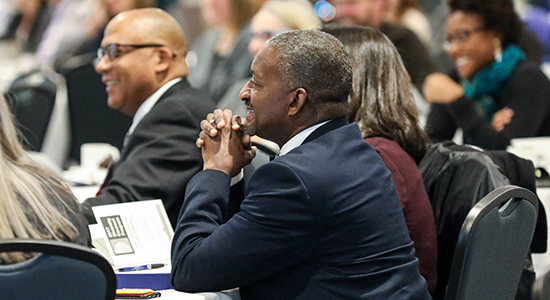
Judge Carl Ashley, chairperson of the State Bar Diversity and Inclusion Oversight Committee, reacts to the panel discussion.
Leaders as Advocates
A consistent and effective diversity and inclusion program requires commitment from your firm’s or organization’s leaders. Smaller firms may find it easier to quickly effect change.
If you aren’t in charge of your office’s or firm’s strategic planning, do what you can to get those planners on board. “One person – or a handful of people – can really start a movement,” Jackson said.
Everyone has a role in this work. “If you are the only one at your firm who is interested in diversity and inclusion, make an impact where you can,” White said.
It also means taking a look at your firm’s policies and procedures, such as with health care, said Russell. How do you reference ‘spouses’ in company policies? Does your health care policy cover diverse relationships? Do fathers get child leave, and lesbian couples have access to fertility treatment? Check over your job descriptions and employee handbooks, if you have them: is the language gender-neutral?
State Bar of Wisconsin Definition of Diversity and Inclusion
The State Bar Diversity Task Force developed and the Board of Governors adopted a definition of diversity and inclusion. Read the Task Force’s June 2014 report and recommendations. The definition:
The term “diversity” has a dynamic meaning that evolves as the demographics in the state change. It is an inclusive concept that encompasses, among other things, race, ethnicity, national origin, religion, gender, gender identity, age, sexual orientation, and disability. Inclusion helps to create a culture that embraces people from the widest range of talent and experience and promotes understanding and respect for all people and different points of view in the legal profession.
Beyond Hiring: Inclusion
Inclusion means that your new associates and employees feel welcome and an integral part of the firm or office. And if you can’t hold on to diverse employees, there’s an inclusion problem in the culture of your firm or office.
“It’s easier to hire someone. But if you can’t keep them empowered and engaged, your investment is all for nothing, and the organization doesn’t benefit,” said St. Vincent. “If people feel included, they will feel a part of the organization.” And they will be more productive.
“Get to know the new associate as a person,” White said. “The idea is being comfortable enough to bring your whole self to work – that is very important, especially in a small firm.”
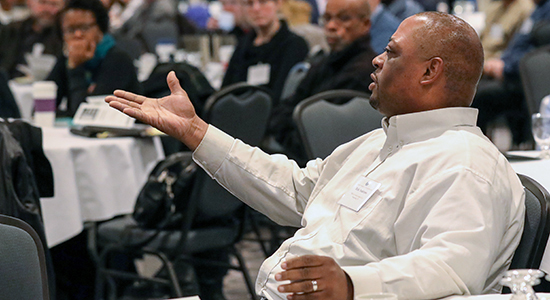
Eric Andrews, a member of the State Bar Diversity and Inclusion Oversight Committee, raises a point of discussion.
An Evolving Process
“This work never really ends – it evolves,” Jackson said. “Make sure you’re adjusting what you need to do to continue to grow your efforts.”
Keeping a diverse workforce requires ongoing effort, including reviewing and renewing diversity and inclusion efforts. It requires regular training of employees as well as leadership.
That training can include coaching. “To start personally, find a mentor,” said St. Vincent. “I reached out to someone who wasn’t like me, who mentors me every month.” They freely discuss race and equality.
Study after study shows that having a diverse workforce boosts business results.
Foster opportunities for employees to network internally – and give them a voice. “Have an open door to allow people to come in and have those difficult conversations,” Jackson said.
Other methods include connecting with others outside your firm and seeking training opportunities in the community – an example is the Madison Area Diversity Roundtable.
“Keeping the work fresh is critically important,” Jackson said. “Look for continuing opportunities for learning and growth.”
Learn More at the 2018 State Bar Annual Meeting & Conference: Dana Tippin Cutler
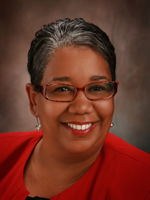 “We make better decisions and we come up with better ideas for policies and programs when you have a breadth of life experiences and viewpoints to serve not only lawyers, but also our clients.” – Dana Tippin Cutler, “Courage to Face the Future.”
“We make better decisions and we come up with better ideas for policies and programs when you have a breadth of life experiences and viewpoints to serve not only lawyers, but also our clients.” – Dana Tippin Cutler, “Courage to Face the Future.”
A past president of the Missouri Bar, Cutler created Courageous Collaboration, which provides a safe space for open and honest discussion among lawyers. Cutler will speak on starting a dialogue at your own firm at the 2018 State Bar Annual Meeting & Conference in June.
No One Left Behind
There’s no question – we live in a polarized society, which can directly affect your employees, St. Vincent said. “Statements and actions by the leaders in our country create fear in our employees. We want to keep respect and trust in the workplace,” so employees can work together to their full potential. “Reinforce that the work environment is a trusted and safe space,” he advises.
Responses to criticism and questioning of the reasons behind diversity and inclusion require forethought. Think ahead to have a response that doesn’t put the firm at risk, yet is in line with the firm’s inclusion policy, Russell said.
Lawyers are problem solvers. “Just as with any other issue, do the research for diversity and inclusion, get comfortable with the issues, weigh the risks, and implement,” White said.
“Get people comfortable with the idea,” she said. “And make sure you aren’t the roadblock.”
Diversity and Inclusion: Books, Podcasts, Websites
Here are Raymone Jackson’s recommended diversity and inclusion resources:
You May Also Like …
-
“It’s the Right Thing to Do,” Wisconsin Lawyer, January 2018
-
“Everyone Has Implicit Bias: If We acknowledge It, We Can Address It,” InsideTrack, Oct. 18, 2017
-
“Cultural Competence Improves Client Communication,” InsideTrack, Nov. 1, 2017
-
“Strategies Toward Diversity and Inclusion: Set a Course for Change,” InsideTrack, Nov. 1, 2017
-
“Opening Paths, Broadening Minds: A Law Student’s Diversity Clerkship Experience,” Nov. 16, 2016. Learn more about the State Bar’s Diversity Clerkship Program.
Endnote
1 Vivan Hunt, Lareina Yee, Sara Prince, Sundiatu Dixon-Fyle, “Delivering through diversity,” McKinsey&Company, January 2018.
